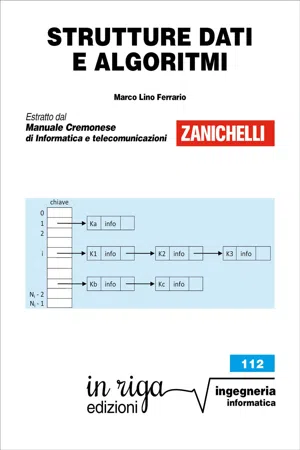Strutture dati e algoritmi
About this book
Uno dei problemi fondamentali dell'informatica consiste nella modellazione dell'informazione secondo categorie che ne permettano la rappresentazione, l'elaborazione e la memorizzazione con sistemi automatici. Le informazioni sono rappresentate per mezzo di dati. Partendo da dati intrinsecamente primitivi, come per esempio i numeri interi o i caratteri, è possibile definire dati più complessi, aggregati dei precedenti, ottenendo così strutture dati sempre più articolate. Le esigenze di generalizzazione hanno portato addirittura a definire tipi di dati astratti, nei quali esiste una netta separazione fra l'implementazione interna e l'interfaccia che definisce le operazioni possibili sui dati. Per esempio, nel caso di una pila (stack) sono definite soltanto le operazioni di inserimento ed estrazione di un elemento. Gli elementi possono essere inseriti e rimossi solo partendo dalla prima posizione. L'astrazione della struttura dati si manifesta considerando che nella pila è possibile inserire e rimuovere dati di qualunque tipo. Sui dati vengono eseguite operazioni. Fra le operazioni normalmente necessarie in qualsiasi ambito applicativo, sono particolarmente importanti la ricerca e l'ordinamento dei dati. Un metodo di ricerca efficiente permette di ridurre il tempo e il costo computazionale necessari per identificare un dato. L'ordinamento dei dati ne favorisce la ricerca. Ricerca e ordinamento sono esempi di algoritmi, ovvero sequenze finite e ordinate di azioni elementari che descrivono la soluzione di un problema. Sommario: 1. INTRODUZIONE AGLI ALGORITMI E AI TIPI DI DATI • 2. TIPI DI DATI PRIMITIVI • 3. TIPI DI DATI DERIVATI – 3.1. Array – 3.2. Matrici – 3.3. Stringhe – 3.4. Record – 3.5. Strutture complesse – 3.6. Puntatori – 3.7. Liste – 3.8. Alberi – 3.9. Trasformazioni hash • 4. RICERCA DI DATI – 4.1. Ricerca sequenziale – 4.2. Ricerca binaria • 5. ORDINAMENTO DI DATI – 5.1. Ordinamento per inserimento – 5.2. Ordinamento per selezione – 5.3. Ordinamento per scambio a bolle – 5.4. Ordinamenti evoluti: shellsort – 5.5. Ordinamenti evoluti: quicksort • 6. COMPLESSITÀ DEGLI ALGORITMI.
Frequently asked questions
- Essential is ideal for learners and professionals who enjoy exploring a wide range of subjects. Access the Essential Library with 800,000+ trusted titles and best-sellers across business, personal growth, and the humanities. Includes unlimited reading time and Standard Read Aloud voice.
- Complete: Perfect for advanced learners and researchers needing full, unrestricted access. Unlock 1.4M+ books across hundreds of subjects, including academic and specialized titles. The Complete Plan also includes advanced features like Premium Read Aloud and Research Assistant.
Please note we cannot support devices running on iOS 13 and Android 7 or earlier. Learn more about using the app.
Information
Table of contents
- 1. INTRODUZIONE AGLI ALGORITMI E AI TIPI DI DATI
- 2. TIPI DI DATI PRIMITIVI
- 3. TIPI DI DATI DERIVATI
- 3.1. Array
- 3.2. Matrici
- 3.3. Stringhe
- 3.4. Record
- 3.5. Strutture complesse
- 3.6. Puntatori
- 3.7. Liste
- 3.7.1 Tecniche di allocazione della memoria
- 3.8. Alberi
- 3.9. Trasformazioni hash
- 4. RICERCA DI DATI
- 4.1. Ricerca sequenziale
- 4.2. Ricerca binaria
- 5. ORDINAMENTO DI DATI
- 5.1. Ordinamento per inserimento
- 5.2. Ordinamento per selezione
- 5.3. Ordinamento per scambio a bolle
- 5.4. Ordinamenti evoluti: shellsort
- 5.5. Ordinamenti evoluti: quicksort
- 6. COMPLESSITÀ DEGLI ALGORITMI
